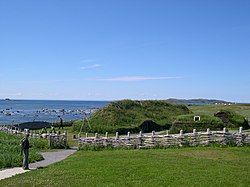Leif Erikson

Leif Eriksson or Ericsson, Erickson, and Ericksson (c. 970 – c. 1020) was a Norse explorer.[1] He was the first known European to travel to North America.[1]
Erikson was probably born in Iceland between 970-975 and grew up in Greenland. He had two brothers named Thorstien and Thorvald and a sister named Freydís. His father was Erik the Red,[1] who had created colonies in Greenland. Eriksson is said to have visited North America long before anyone else in Europe did.[1] According to Icelandic sagas (stories) he started a Viking settlement in Vinland. Many people think this was L'Anse aux Meadows in Newfoundland in Canada. After landing in North America and when he was going back to Greenland, he rescued a man in his crew who had sunk. From that moment on, he was called “Leif the Lucky”. He is generally believed to be the first European to reach the North American continent, nearly four centuries before Christopher Columbus arrived in 1492.
Leif Erikson Media
Leif Eriksson Discovers America by Hans Dahl (1849–1937)
The words Leifr hinn heppni, "Leif the Lucky", written out in the early 14th century Hauksbók, the oldest manuscript of the Saga of Erik the Red
Modern recreation of the Norse site at L'Anse aux Meadows. The site was originally occupied c. 1021 and listed by UNESCO as a World Heritage Site in 1968
Discovery of America, a postage stamp from the Faroe Islands which commemorates both Leif Erikson and Christopher Columbus
Leif Erikson memorial statue at Shilshole Bay Marina, Port of Seattle
Leif Eriksson Memorial (1929–1932), Reykjavík, Iceland. This statue is at the front of the Hallgrímskirkja. There is a copy of this statue in Newport News, Virginia, USA.
Leif Erikson by John K. Daniels, 1948–49, near the Minnesota State Capitol.
A 'Leif Ericson' proof dollar from the United States, minted in 2000. It reads 'Founder of the New World'
References
- ↑ 1.0 1.1 1.2 1.3 "Leif Eriksson the Lucky". Encyclopædia Britannica. Retrieved 6 March 2011.








